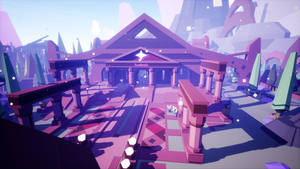Different Types of Game Artists
A game needs written code to execute 'behaviour'. It needs 'design' to function according to concept, and it also needs 'visuals' to give the game style and character. Game Artists take care of that artistic job.

A game needs written code to execute 'behaviour'. It needs 'design' to function according to concept, and it also needs 'visuals' to give the game style and character. Game Artists take care of that artistic job. The word 'Artist' doesn't refer to a performing, singing or song writing game developer. It's more like the 'Michelangelo' and 'DaVinci' kind of 'Artist'. Artists from the early days played around with paint, pencil and crayons. Some of them still do but have to implement this digitally at some point. Therefore they usually work with a modern type of 'canvas' called a 'Wacom Tablet'. In this article I will describe some different 'Game Artist Species' and how to work with them.

source: Inspired2act http://inspired2act.com/index.php/Inspired_Action/posts/195/
The Environmentalist
These Artists do not particularly like to walk naked into the woods. They like to draw large scale environments. Usually they come up with a story before they start drawing, or make one up when the piece is finished. It is like they give a storywise definition that expains 'why' they made these artistic choices in a piece of art. These Artists have a great perception of depth, scale and perspective. Most of them are quite fast with a drawing, wether or not with a series of drawings. You can use them greatly for concept art on a 3D game project. They can define the visual style and breathe atmosphere into a scene. In this role they are the designer of the world and the 3D artist is the executor. You can also use them directly when creating 2D games. Think about paralax backgrounds that scroll by, or special places, in short they can create your game's world.

source: End of the line by Thomas Stoop http://www.thomasstoop.com/end-of-the-line/
The Charactarist
Artists like this are specialized in the creation of 'Characters' in your game. They can give birth to the most crazy creatures you've ever seen. In my experience, these artists are all about the details. These artists take their sweet time to create something perfect. Usually a lot of 'iteration' is needed to get just that perfect character. After they lay down the basics, they can create different versions to give a broad idea what is possible with a character. They are however creating the centerpieces of the game. That is why they have to be deligate and precise. If your concept reaches into a pool of characters, start your character artist early in the process. It takes time to get to a final character concept.

source: Abomination by Leonardo Metz Art http://www.behance.net/gallery/Abomination/6624755
The Polygonalist
These Artists like to play around in a 3D environment. You can also split this type into different types of 3D artists, but it will get far too confusing, so I will just stick with the 3D Artist in general. All these Artists work in a very complex 3D environment. There are huge differences between these applications. At the end it's all a matter of 'taste'. Some of them work with 'Autodesk Maya', some of them work with 'Blender', and others would say 'Modo' is the way to go. If you want to create a 3D game, having a 3D artist is a must. You can argue with me that you can buy and download 3D models and use them in your game, but will you ever reach consistancy, harmony and be original at the same time? I don't think so. That is why we still need these artists to create something of their own. This usually starts with concept art that is created by an Character artist or Environmental artist. The next step is to create the 3D model, create a skeleton and finish it by giving it a nice animation.

source: Models by Dax Erken http://www.digitalforest.nl/portfolio-3/robots/
The Texturist
When a 3D model is done, it looks like a puppet of clay. Therefore a skin is needed to give the model it's clear details. This skin is called a 'texture'. Texture artists are working with a lot of bounderies. They can not define everything how they like. To create a 'texture' a 3D model needs to expand. Expanding is called 'unwrapping'. It is like unwrapping a present at your birthday, the difference is; First you have to unwrap it imensly precise and secondly there is nothing in there because models are empty shells. Sound like a fun present right? When you have a 2D unwrapped version of the model, a Texture artist can start painting all the details on there. He keeps in mind all the precise bounderies, bends and folds. At the end the model is provided with a detailed nice looking skin.

source: Crates & Barrels by Vincent da Silva http://www.digitalforest.nl/
The Visualist
So having checked off all the accesories needed for your game, you also need someone that creates the 'User Interface'. Well believe me, this is something different than creating characters, environments and/or 3D models. Visual/GUI Artists need to design and create from a user's perspective. They have knowledge about 'how' a user interacts with systems. They have a great feel in color palletes, know 'which colors initiate 'what' feeling by a player in 'what' context. This proces goes hand in hand with testing a game. If players do not understand a certain part of the system, it goes immediately in reproduction. Where a Character artist can move his mind freely, a Visual artist is restricted to a set of rules. They have to communicate with Game and Level Designers to understand what is meant by something in the game.

source: Expandaball GUI by Sebastiaan van Asperen http://stitched2gether.blogspot.nl/
Concluding
There are many more types of artists. But if I have to sum up the 'core' artists that work in small independent teams, I think these are the one's you find the most. It's great to work with all of them. Some of them are really strict and precise and create a lot of possibilities. Some of them you need to attach to a chain, and when needed, pull them in the right direction. They all share a great creative mind.
/Koen
Find Me On:
Blog: http://www.koendeetman.com
Twitter: @KoenDeetman
Facebook: Koen.Deetman
Company: KeokeNInteractive
Ask me a question anytime at:
http://ask.fm/koendeetman
Read more about:
BlogsAbout the Author(s)
You May Also Like













